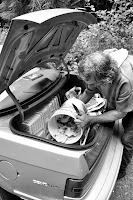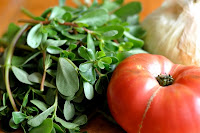Doug makes his living as a full-time, year-round mushroom picker. He picks the Washington Coast near his Westport home in the fall, travels south to pick California in the winter, and marches back up the east slope of the Cascades following the spring pick, sometimes up into British Columbia if the pick is good.
The other day I tagged along with Doug to see how it was done.
 To say Doug is an interesting character is to make a broad understatement. He’s been a logger, served in the military, and captained a crab boat. When you drive around the Olympic Peninsula’s down-at-the-heels timber communities with Doug in his $500 Buick Century sedan, you spend a lot of time waving to the people you pass, all friends or former colleagues: shake rats*, long-liners, other pickers, and those three old codgers jawing around the tailgate at the general store.
To say Doug is an interesting character is to make a broad understatement. He’s been a logger, served in the military, and captained a crab boat. When you drive around the Olympic Peninsula’s down-at-the-heels timber communities with Doug in his $500 Buick Century sedan, you spend a lot of time waving to the people you pass, all friends or former colleagues: shake rats*, long-liners, other pickers, and those three old codgers jawing around the tailgate at the general store.
More important, at least in terms of Doug’s livelihood, you also spend a lot of time visiting trees that might as well be personal friends. Within a mile or two of our meeting place we pulled over beside a fork of the Hoquiam River. A single sitka spruce of less than 100 years age was busy cranking out porcini buttons. Doug has known this tree a long time and he’ll stop by for a visit every now and again to say hello and load up on the porcini that spring from its roots like Athena out of Zeus’s head.
After that we visited a hedgehog patch. I found myself struggling to keep up. Doug knows exactly where the mushrooms are. He has patches up and down the West Coast, has in fact forgotten more patches than most pickers will ever know. When you follow Doug through the salal and huckleberry and old cedar slash, you’re following a man who has created little trails through the forest just like the deer and elk and bears. These trails lead directly to mushrooms, which end up in his bucket by the pound, and are later emptied into baskets to be weighed by the buyer.
Doug prides himself on providing good product. His mushrooms are fresh, clean, and unblemished.
After picking hedgehogs we visited a chanterelle patch and another porcini patch. A good portion of Doug’s day is spent scouting. The chanterelle patch needed another week and he figured his early porcini patch was about to pop. He predicted a 30-pound haul for the following day, and when I talked to him on the phone the next night he said it put out 35 pounds—and that was just the beginning. He’ll be visiting that patch every other day for the next week or two until the patch peters out.
Meanwhile the hedgehogs were just coming on and there were always chanterelles to pick. Plenty of chanterelles. When I asked Doug why he picked, he didn’t talk about the money or the virtue of hard work or the allure of being your own boss. It was all about the woods. To pick mushrooms on a daily basis is to be intimately involved in the web of life. Doug knows which salmon streams still have decent runs of wild fish, where to find the best berries, and how to lose himself in the forest’s grandeur without getting lost.
Writers have an expression: a writer’s writer might be unknown to the critics and taste-makers, but earning the admiration of fellow scribes is the highest honor. Doug is a picker’s picker.
* A shake rat is a logger who specializes in cutting cedar shakes, or shingles.






























